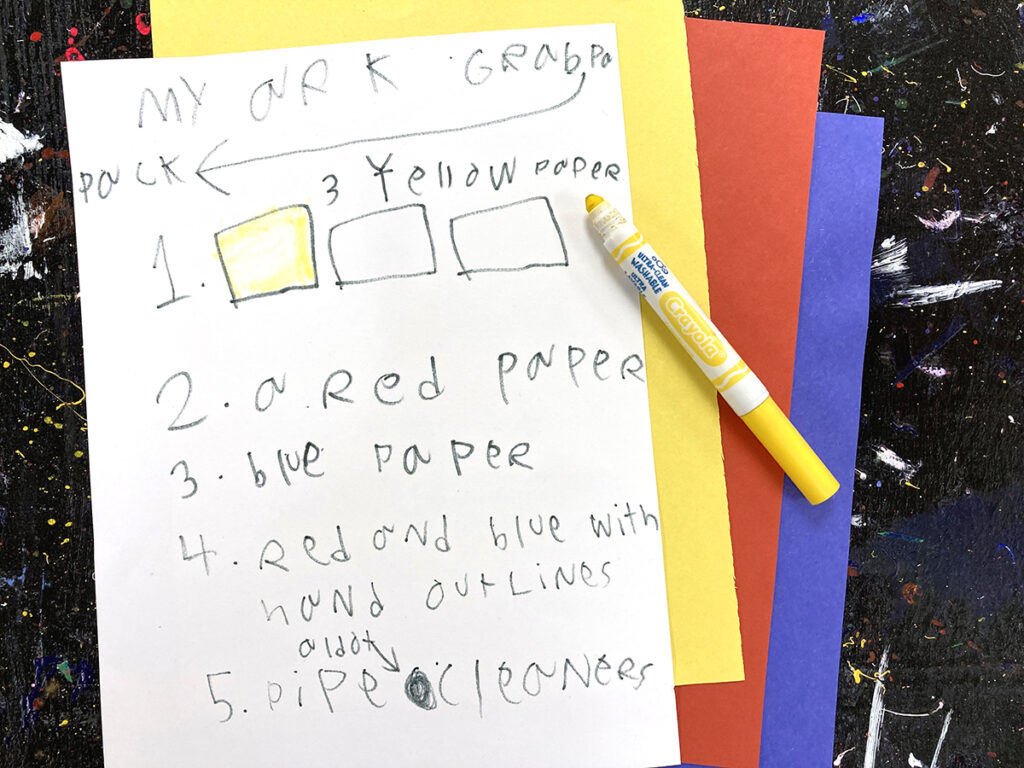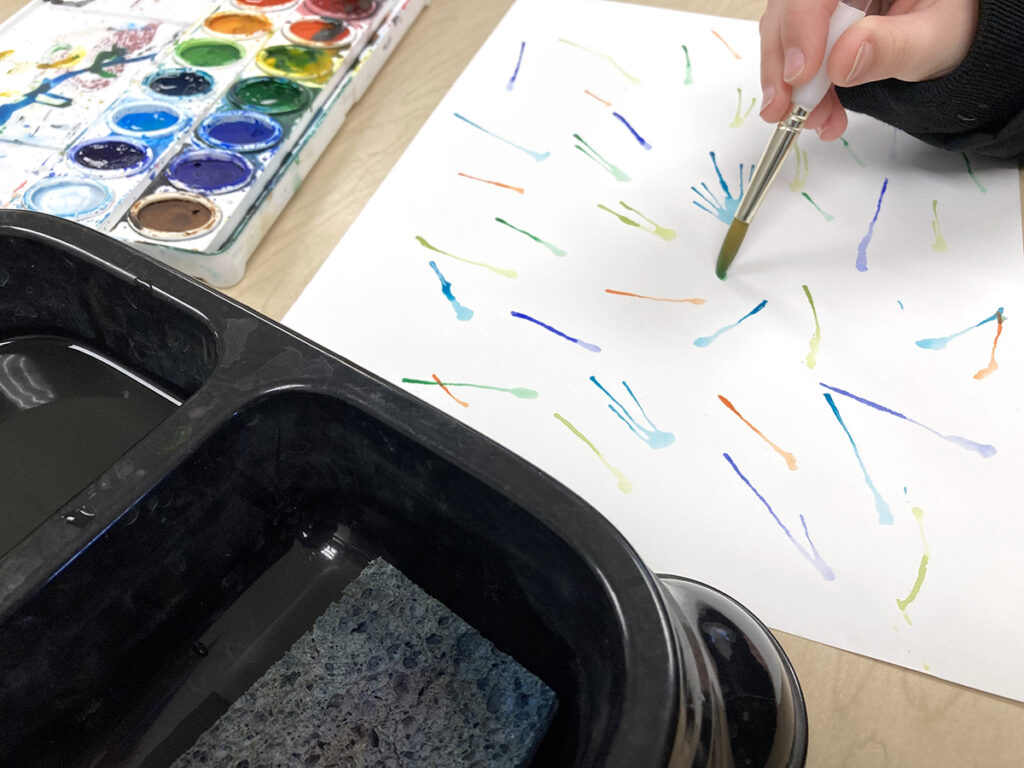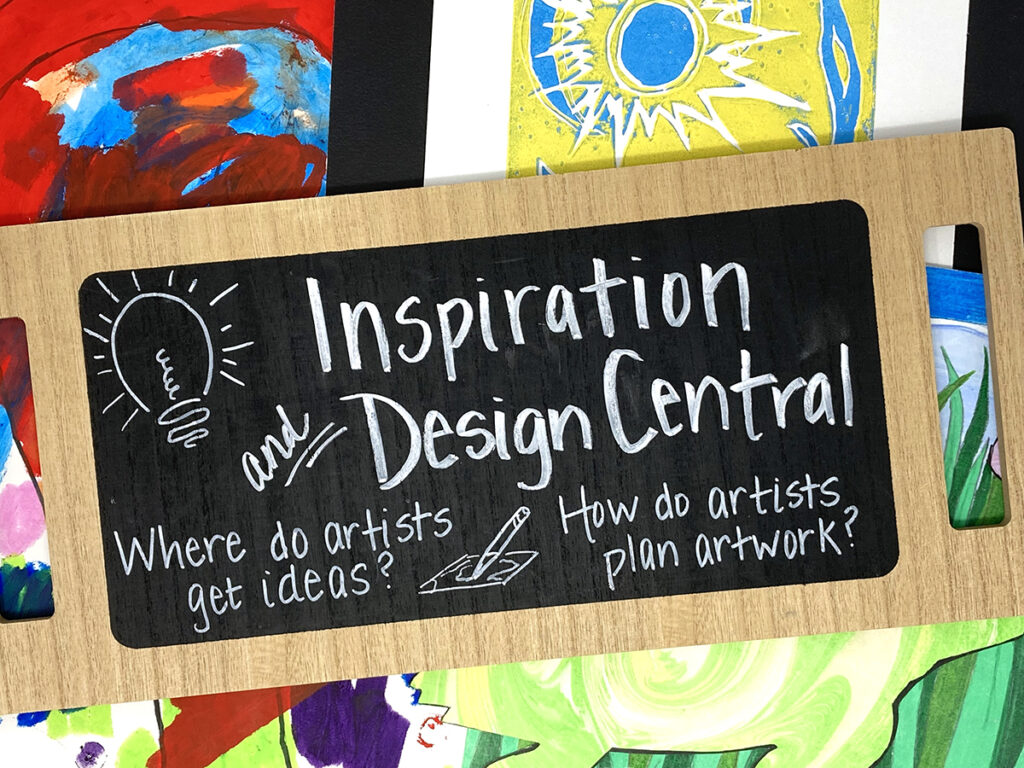Examples of the National Core Arts Standards in a Classroom
Art teachers are experts at coming upward with lesson plans that are artistic and engaging. You may be required to align your lessons with land, national, or commune standards. Understanding the National Core Arts Standards (NCAS) will inform planning curriculum and instruction for your art plan and fix your students to be lifelong learners.
Permit'southward explore the National Core Arts Standards together to better equip us equally fine art teachers and our students as artists.
Before nosotros jump in, here is a handy download that provides an overview of the standards. For more resource similar this, check out the PRO Pack, Implementing the National Art Standards.

Download Now!
Implementing the NCAS encourages lifelong learning.
The National Cadre Arts Standards are aligned with the iv creative processes: Creating, Presenting, Responding, and Connecting. These processes build artistic literacy in your art students. The updated national standards focus on creating creative literacy to support mutual values that connect the arts and lifelong learning. The National Core Arts Standards: A Conceptual Framework, or NCAS, recognizes that the arts serve to encourage "communication," "creative personal realization," cultural and historical awareness, relationships and connections, "wellbeing," and "community engagement." These are valuable life skills that go across the art room. We can plant the seeds at a young historic period through a quality arts educational activity.
According to The Artistic Literacy Institute, artistic literacy is "a human correct and a teachable skill. It is the ability to connect both personally and meaningfully to works of art and, through this process, to forge connections to our humanity and the humanity of others." When you lot consider how you create those types of connections in your art room, you tin use the national standards to strengthen your existing curriculum and dive deeper into the creative process.
Strengthen the artistic experience for all of your students by starting with these 4 processes.
Creating artwork or inspiring others to do the aforementioned may accept led you into art education. When y'all appoint in artmaking, you generate ideas, brand meaningful connections, reverberate, and peradventure share your work with others. Every bit you read about each of the four processes, think about how your do of creating art aligns with the processes and how yous tin aid guide your students through them.

one. Creating
The process focused on Creating may be the 1 thing (creating artwork) that most people associate with visual arts. As art teachers, we know that a lot goes into the creation procedure. From coming upwards with ideas to completing the artwork, creating can encompass information technology all.
There are three anchor standards for Creating:
- Anchor Standard i: Generate and conceptualize artistic ideas and work.
- Anchor Standard 2: Organize and develop artistic ideas and piece of work.
- Anchor Standard 3: Refine and complete artistic piece of work.
What does Creating look like in the art room?
The National Core Arts Standards: A Conceptual Framework for Arts Learning defines Creating as "conceiving and developing new artistic ideas and piece of work." The ballast standards listed above can guide you equally you compose learning objectives aligned with the creative process. They are also expectations for what fine art teachers should look for in their students' learning. You can easily place phrases such equally, "The students will" or "The students will be able to" in front of each anchor standard and use it as a learning objective to aid you in lesson planning.
Every bit you lot brainstorm planning your lessons, consider the definition of creating: "conceiving and developing new artistic ideas and work." How are you already fostering original and meaningful thinking in your students? You may already be using brainstorming, writing prompts, creativity exercises, and offering themes and choices in subject thing to guide your students towards generating their own ideas. Developing those ideas into artwork involves exploring materials, media, and techniques. Information technology is a good practice to periodically reverberate on what strategies are in place in your teaching.
Planning artwork tin can include thumbnail sketches, kick camps, sketchbooks, or collaborative activities. Equally your students piece of work through the artistic process, a lot of reflection may need to happen for them to refine and complete their artwork. Reflection can occur at any signal during the creative process. You tin help your students reflect past having them participate in gallery walks, peer feedback, self-reflection, critiques, or show-and-tell mode presentations. Creating and reflecting may accept many forms, and information technology can exist helpful to have a pace back and write down what these look similar in your art room.

ii. Presenting
The national standard for Presenting artwork encompasses performing, presenting, and producing. When considering the definition of this standard, the NCAS emphasizes "realizing," "interpreting," and "presenting creative ideas and work." Permit's suspension down this standard and run into what it ways in the fine art room.
There are three anchor standards for Presenting:
- Ballast Standard iv: Select, analyze, and interpret artistic work for presentation.
- Ballast Standard 5: Develop and refine artistic techniques and work for presentation.
- Ballast Standard 6: Convey meaning through the presentation of creative work.
What does Presenting wait like in the fine art room?
Once the creative procedure begins, artwork has the potential to bring ideas from an internal thought to an external, visual form. Then the visual artwork is presented to the art teacher, peers, family, friends, or whoever the audience may be. Presentations can occur at whatsoever stage in the creation process. Art teachers tin can use presentations every bit learning experiences that are ongoing and reflective.
Presenting may naturally be connected to the physical display of finished artwork, but it is non express to it. When you lot look at the ballast standards and even closer at the NCAS's Visual Arts at a Glance matrix, there are opportunities to learn about the role of presentation as it relates to art. Y'all may teach about venues for an exhibition, including museums, local galleries, or your classroom display. Presenting provides opportunities to discover the relationships between artwork and storytelling, showing significant and cultural illustrations of life and history. Some other avenue to explore is providing the infinite for student autonomy in the presentation of their own artwork. Including students in the controlling process when showing their work can be empowering.

iii. Responding
The National Core Arts Standards: A Conceptual Framework for Arts Learning states that the standard for Responding is "understanding and evaluating how the arts convey pregnant." Responding relies heavily on thinking and communicating. It is an first-class starting point to develop or keep fostering artistic and disquisitional thinking skills.
There are 3 anchor standards for Responding:
- Anchor Standard 7: Perceive and analyze artistic work.
- Ballast Standard viii: Interpret intent and meaning in artistic work.
- Ballast Standard 9: Utilize criteria to evaluate creative work.
What does Responding look like in the fine art room?
Accept you ever thought virtually how you tin can increase learning through effective questioning and communication? When you look closely at the breakdown of grade-level standards, you may detect the sprinkling of verbs linked to Blossom'south Taxonomy. Yous may already be using those higher-club thinking verbs as you write your learning objectives and collaborate with your students.
I mutual strategy you may be incorporating is critiquing artworks. Critiques come up in a variety of forms and can be done at dissimilar stages of the creative process. It is a slap-up way for students to self-assess their own artwork and innovate them to the artwork of others. Critiques can be formal, informal, diagnostic, formative, or summative activities. Yous can even create fun activities that are both entertaining and learning opportunities.
4. Connecting
When exploring the standard of Connecting, the National Cadre Arts Standards: A Conceptual Framework for Arts Learning defines information technology as "relating artistic ideas and work with personal significant and external context." Yous may tap into meaningful connections in your own artwork equally an artist yourself. Because of this, the creation process becomes engaging for you from starting time to finish. Through our ain artmaking experiences, we are expert guides at helping our students find their own inspiration.
There are 2 anchor standards for Connecting:
- Anchor Standard 10: Synthesize and relate knowledge and personal experiences to brand fine art.
- Anchor Standard eleven: Relate artistic ideas and works with societal, cultural, and historical context to deepen understanding.
What does Connecting expect like in the art room?
While Creating fine art with meaningful connections comes naturally for children, the traditional instructor-driven public teaching system may hinder creativity. Fine art teachers have the opportunity to teach creativity strategies and encourage skills that allow students to connect personal meaning, ideas, and experiences with artmaking and artwork. The art room is the perfect identify to cultivate an environment that fuels creativity, and the best part is, you can start correct now.
Making inventiveness a priority in your teaching and learning can be the direct road to coming together the Connecting standard. You can establish a creativity routine that exercises the imagination. For instance, you can use prompts to bring awareness to your students' personal experiences. Teaching for creativity through the artistic process can help students find their own voices and express what is important to them. Brainstorming, timed thumbnail sketches, mind mapping, or collaborative activities tin can help students develop connections between personal ideas and visual artmaking.

Subsequently reading the National Core Arts Standards breakdown, y'all may feel more comfy knowing that y'all are already practicing each of the processes and standards. Remember that y'all are an art teacher. You are familiar with the creative process and an skillful at sharing your passion for artmaking with your students. One time you recognize this, yous will discover it easier to marshal your curriculum with the standards to guide your students' learning.
Listen to these additional resources:
- Listen to Exploring the National Standards: Create (Ep. 206)
- Listen to Exploring the National Standards: Respond (Ep. 207)
- Mind to Exploring the National Standards: Connect (Ep. 208)
- Mind to Exploring the National Standards: Nowadays (Ep. 209)
National Core Arts Standards (2015) National Coalition for Core Arts Standards. Rights Administered by the Land Didactics Agency Directors of Arts Education. Dover, DE, www.nationalartsstandards.org all rights reserved.
NCAS does not endorse or promote any goods or services offered by the Art of Education Academy.
What practise the national standards await like in your art classroom?
How can you lot comprise innovative instruction and learning strategies to foster creative literacy and lifelong learning?
What questions do yous still have near the National Core Arts Standards?
Magazine articles and podcasts are opinions of professional education contributors and do not necessarily represent the position of the Fine art of Instruction University (AOEU) or its academic offerings. Contributors apply terms in the fashion they are most oftentimes talked nigh in the telescopic of their educational experiences.
Source: https://theartofeducation.edu/2022/02/18/feb-what-does-unpacking-the-national-core-arts-standards-look-like/
0 Response to "Examples of the National Core Arts Standards in a Classroom"
Post a Comment